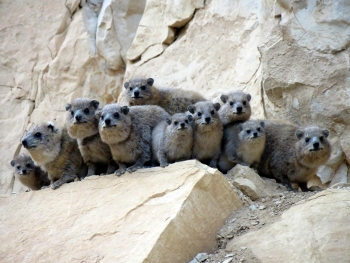Can the Friend of My Friend Be My Enemy?
Choice affects stability of the social network
22 April 2013

|
| Credit: Matan Bogomolsky |
Just as humans can follow complex social situations in deciding whom to befriend or to abandon, it turns out that animals use the same level of sophistication in judging social configurations, according to a new study that advances our understanding of the structure of animal social networks.
The study, which appears today in the journal Animal Behaviour, is the first in which researchers applied a long-standing theory in social psychology called "structural balance," which is used to analyze human relationships, to an animal population to better understand the mechanisms that determine the structure of animal social groups. Researchers analyzed social bonds in behavioral data from a long-term study of the rock hyrax, a small mammal that lives in colonies across Africa and the Middle East.
Structural balance theory considers the positive or negative ties between three individuals, or triads, and suggests that "the friend of my enemy is my enemy" triangle is more stable and should be more common than "the friend of my friend is my enemy" triangle. Another configuration, "the friend of my friend is my friend," is considered to also be a stable configuration in the social network. The last possible triangle, "the enemy of my enemy is my enemy," presages an unstable state, according to the theory.
The potential power of structural balance theory is its ability to predict patterns in the structure of the whole social network and also predict changes that occur over time, as unstable triads are expected to change to stable ones.
"We all live in social networks of some kind, either online or offline, and we are interested in understanding how these groups form and dissolve and their internal dynamics, but while studying these human dynamics is important, it's also very difficult and in many cases impractical. So we study how sociality evolved in animals, which might offer us some insights into our own social behavior. And indeed, the structural balance theory that was developed to study human behavior appears to be relevant in animals as well," said the study's lead author Amiyaal Ilany, a postdoctoral fellow at the National Institute for Mathematical and Biological Synthesis.
In the study, the hyraxes tended to form balanced triads and changed unbalanced triads to balanced triads over time. However, new individuals in the population - new pups or males that migrate into the network - introduced social instability by often forming unbalanced triads, causing the network as a whole to retain some level of instability. The study also found that contrary to classical structural balance theory, the "enemy of my enemy is my enemy" configuration was actually a stable configuration.
The results suggest that structural balance may play a role in the evolution of social structures by selecting against specific configurations. Structural balance may also serve as a psychological mechanism that allows specific social structures to exist and that prevents cooperation between members of different groups.
The authors suggest that structural balance may be prevalent in other species as well.
"The results indicated that changes in social relationships are dependent not only on two individuals, but significantly on third parties, which underscores the importance of structural balance theory in explaining the evolution of complex natural social systems," Ilany said, who was a doctoral student at Tel Aviv University when the research was begun.
Citation: Ilany A, Barocas A, Koren L, Kam M, Geffen E. 2013. Structural balance in the social networks of a wild mammal. Animal Behaviour. Published [online] 21 April 2013.
Media Highlights
Science 2.0:
Structural balance: Rock hyrax has frenemies too
Red Orbit:
For the rock hyrax, a balanced triad is best within the social group
ScienceBlog:
Friend or foe? Choice affects stability of the social network
#
The National Institute for Mathematical and Biological Synthesis (NIMBioS) brings together researchers from around the world to collaborate across disciplinary boundaries to investigate solutions to basic and applied problems in the life sciences. NIMBioS is supported by the National Science Foundation, the U.S. Department of Homeland Security, and the U.S. Department of Agriculture with additional support from The University of Tennessee, Knoxville.
CONTACT INFORMATION: Catherine Crawley, NIMBioS at ccrawley@nimbios.org; 865-974-9350
NIMBioS
1122 Volunteer Blvd., Suite 106
University of Tennessee
Knoxville,
TN 37996-3410
PH: (865) 974-9334
FAX: (865) 974-9461
Contact NIMBioS


